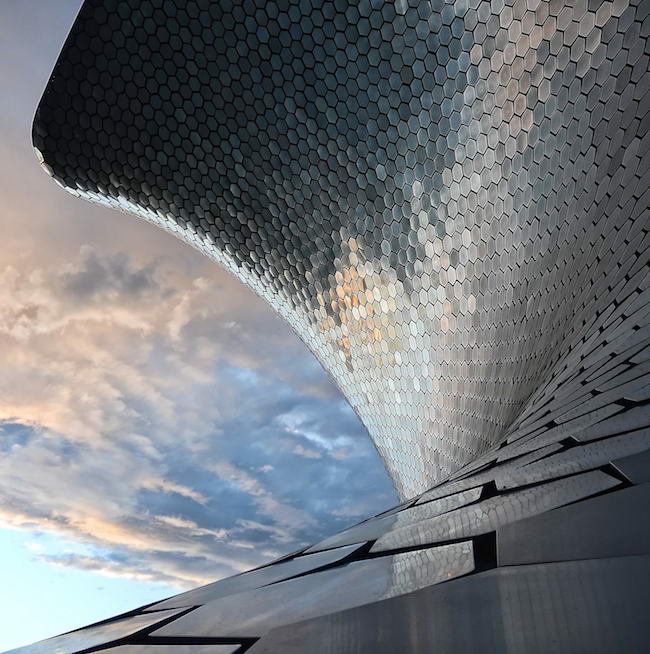MEXICO CITY — According to some critics the tile facade on the soaring Museo Soumaya in Mexico may be it’s best feature. The 2011 building, designed by FR-EE studio, is a rhombus that rises 150 feet into the air, cinched in the middle like a corset. It is adorned with 16,000 hexagonal tiles made of mirrored steel and ceramic.
“(The tiles refer to) the traditional colonial ceramic-tiled building facades in Mexico city and (give) the building a distinctly different appearance depending on the weather, time of day, and the viewer’s vantage point,” the architects state.


The museum is home to a collection of art owned by multibillionaire telecom owner Carlos Slim. The museum, which he calls a “gift” to his country, houses more than 70,000 works of art, including (casts of) Aguste Rodin sculptures. The architects call the collection “eclectic,” while critics wouldn’t describe it that politely. Out of the six floors in the building, a writer for the LA Times guessed that there were maybe two floors of art to get excited about.
“Actually, even that should not have been a surprise. A vanity museum, the Soumaya has been housed in a more modest space in the Coyoacán district for several years, but a sharp curatorial sensibility has never been much in evidence. If you love Salvador Dali’s cheesy Surrealist bronze sculptures of the 1970s and 1980s, churned out for moneyed provincial buyers; posthumous (if authorized) casts of Auguste Rodin masterworks; or, sentimental Victorian odes to childhood innocence, carved in marble, this is the place for you.
“The top floor is a veritable football field crowded with scores of examples of the stuff, each on its own white pedestal. The forest of impossible-to-contemplate material even obscures significant works, such as fine terra cottas by Jean-Baptiste Carpeaux (1827-1875). The overhead fluorescent lighting is, well, fluorescent.”
The critic goes on to point out some failings of the interior and it’s difficult to know whether this is poor design or poor curation.
Throughout, the museum installation feels rushed. What possesses a curator to position a large, finely wrought Spanish Colonial sculpture of the Christ child in a vitrine pushed up next to a bright-red fire extinguisher and an emergency-exit door? Overhead track lights illuminate the limed-wood floors at the base of free-standing walls, all stark white, apparently in an attempt to bounce indirect light onto paintings; instead, hot spots illuminate baseboards, while paintings are shadowed at the top.
FR-EE has been a studio for more than 15 years, according to their company biography. Based out of New York and Mexico City, the firm works with site and public space in urban locations. It’s founder, Fernando Romero, was named a Global Leader of Tomorrow at the World Economic Forum in 2002. He was named one of the 50 most influential designers by Fast Company in 2012. He is an honorary fellow of the American Institute of Architects.
Do you love or loathe this use of contemporary ceramics? Let us know in the comments.


Photographs by Rafael Gamo, Adam Weisman, Raul Soria, courtesy of the architects.







Add your valued opinion to this post.